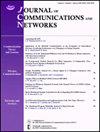Overview of various methods for decoding and constructing critical sets of polar codes
IF 2.9
3区 计算机科学
Q2 COMPUTER SCIENCE, INFORMATION SYSTEMS
引用次数: 0
Abstract
Polar codes have gained significant attention in recent years as they offer a promising solution for reliable communication in the presence of channel noise. However, decoding these codes remains a critical challenge, particularly for practical implementations. Traditional decoding methods such as belief propagation and successive cancellation suffer from complexity and performance issues. To address these challenges, authors have researched several low-complexity decoding techniques, including bit-flipping decoding with critical set construction. Bitflipping decoding methods operate by flipping a limited number of bits in the received codeword to bring the decoder output closer to the transmitted message. The critical set construction is an essential component of these methods, which identifies the set of bits to be flipped. This paper compares various bit-flipping decoding methods with different critical set constructions, including revised critical set, subblocks-based critical set, key set and others. The performance of these methods is evaluated in terms of bit error rate, computational complexity, and an average number of operations. In summary, this paper provides a comprehensive overview of bit-flipping decoding methods with critical set construction for polar codes. The paper's findings highlight the potential of these methods to improve the performance and reliability of polar codes, making them a viable option for practical implementation in modern communication systems.极性码的各种解码和临界集构建方法概述
近年来,极地编码备受关注,因为它们为在信道噪声环境下进行可靠通信提供了一种前景广阔的解决方案。然而,对这些编码进行解码仍然是一项严峻的挑战,尤其是在实际应用中。传统的解码方法,如信念传播和连续抵消,存在复杂性和性能问题。为了应对这些挑战,作者们研究了几种低复杂度解码技术,包括利用临界集构建的比特翻转解码。比特翻转解码方法通过翻转接收到的编码字中数量有限的比特,使解码器输出更接近传输的信息。临界集构造是这些方法的重要组成部分,它确定了要翻转的比特集。本文比较了采用不同临界集结构的各种比特翻转解码方法,包括修正临界集、基于子块的临界集、关键集等。本文从误码率、计算复杂度和平均操作次数等方面对这些方法的性能进行了评估。总之,本文全面概述了极性码临界集构造的比特翻转解码方法。本文的研究结果凸显了这些方法在提高极性码性能和可靠性方面的潜力,使其成为现代通信系统中实际应用的可行选择。
本文章由计算机程序翻译,如有差异,请以英文原文为准。
求助全文
约1分钟内获得全文
求助全文
来源期刊
CiteScore
6.60
自引率
5.60%
发文量
66
审稿时长
14.4 months
期刊介绍:
The JOURNAL OF COMMUNICATIONS AND NETWORKS is published six times per year, and is committed to publishing high-quality papers that advance the state-of-the-art and practical applications of communications and information networks. Theoretical research contributions presenting new techniques, concepts, or analyses, applied contributions reporting on experiences and experiments, and tutorial expositions of permanent reference value are welcome. The subjects covered by this journal include all topics in communication theory and techniques, communication systems, and information networks. COMMUNICATION THEORY AND SYSTEMS WIRELESS COMMUNICATIONS NETWORKS AND SERVICES.

 求助内容:
求助内容: 应助结果提醒方式:
应助结果提醒方式:


